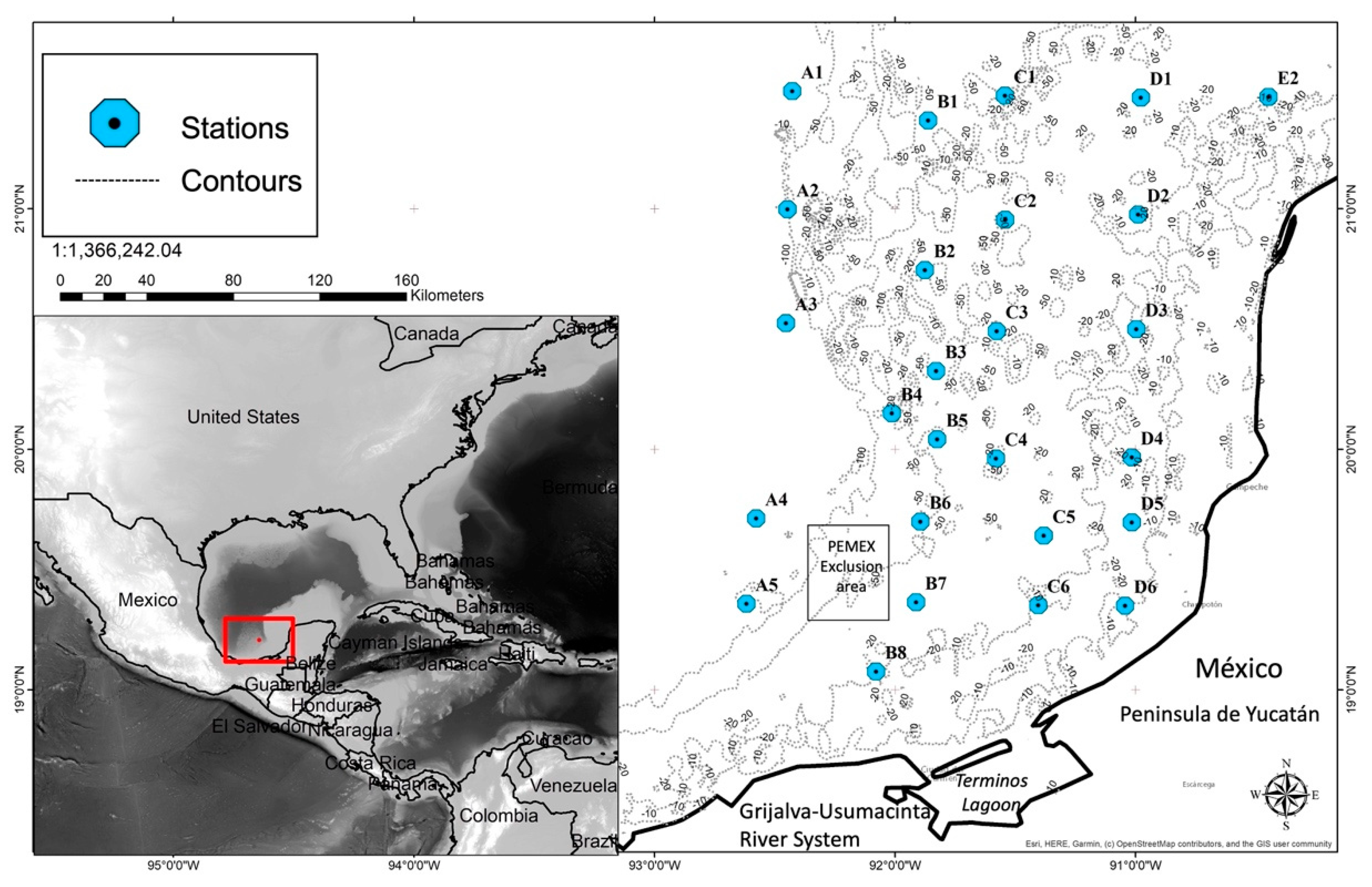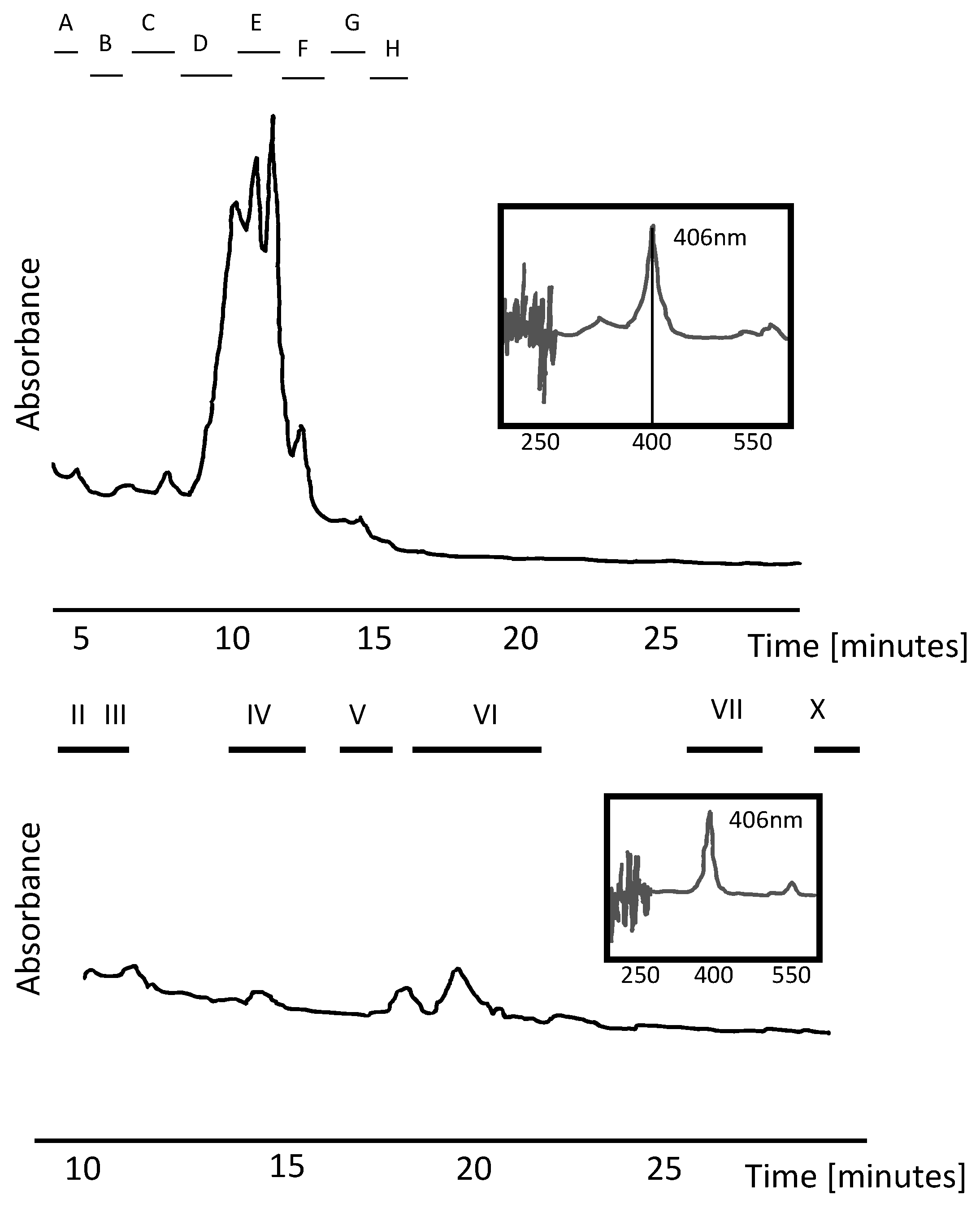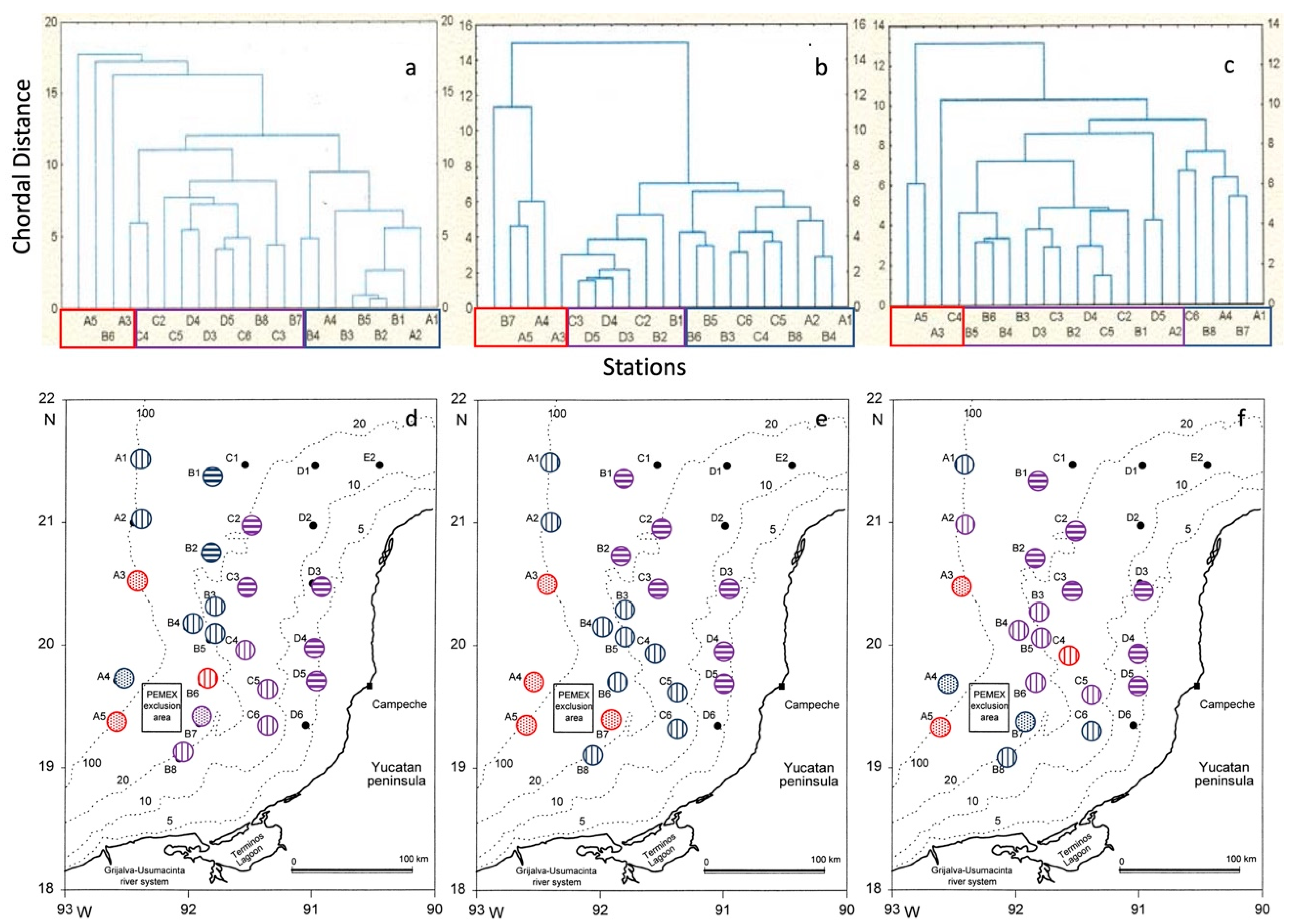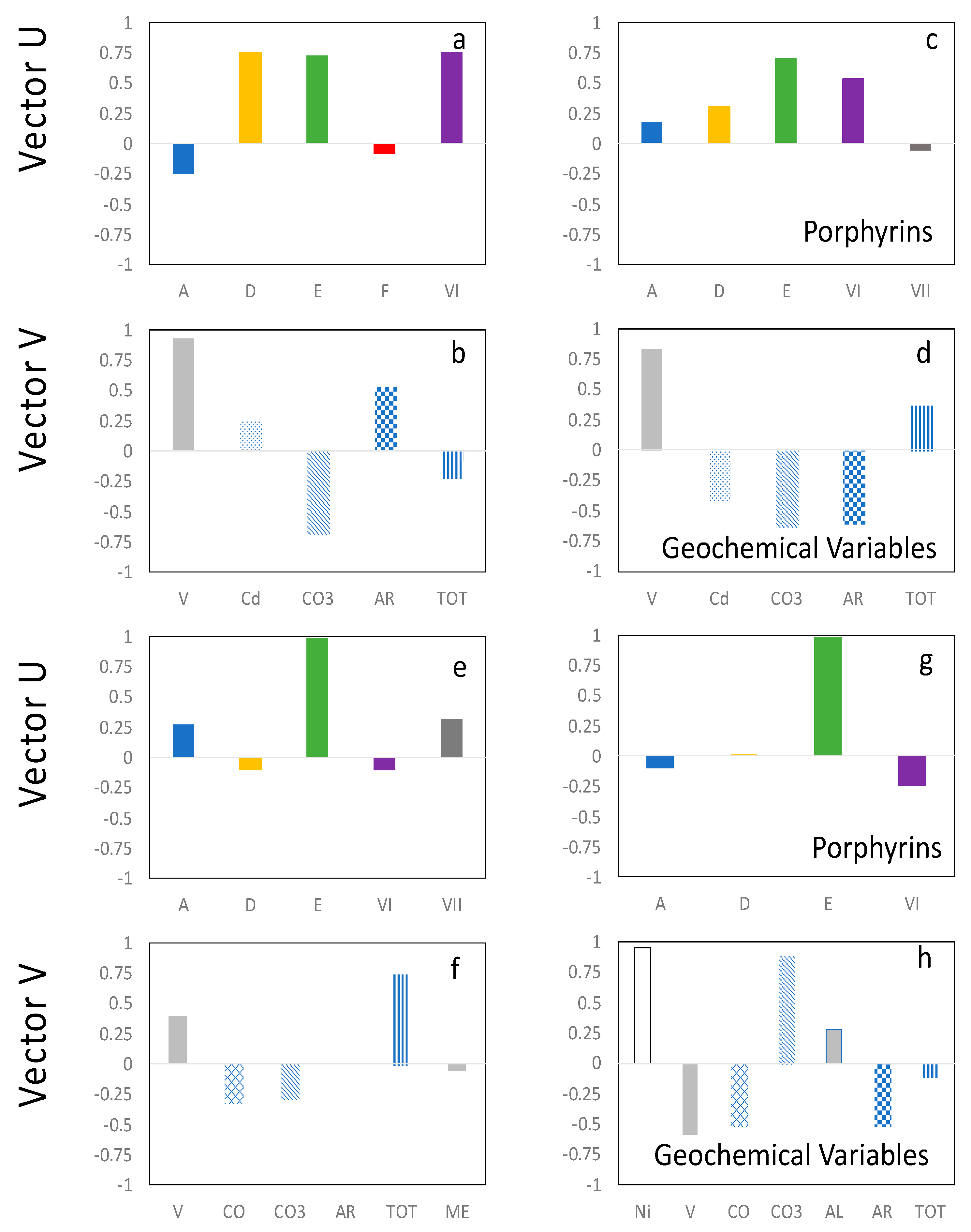Geospatial Synthesis of Biogeochemical Attributions of Porphyrins to Oil Pollution in Marine Sediments of the Gulf of México
Abstract
:1. Introduction
2. Materials and Methods
2.1. Sampling
2.2. Porphyrin Analysis
2.2.1. Extraction
2.2.2. Instrumental
2.3. Statistical Analysis
3. Results
4. Discussion
5. Conclusions
Supplementary Materials
Author Contributions
Funding
Data Availability Statement
Acknowledgments
Conflicts of Interest
References
- Quirke, J.M.E.; Eglinton, G.; Palmer, S.E.; Baker, E.W. High performance liquid chromatography and mass spectrometric analyses of porphyrins from deep-sea sediments. Chem. Geol. 1982, 35, 65–85. [Google Scholar] [CrossRef]
- Baker, E.W.; Louda, W. Highly dealkylated copper and nickel etioporphyrins in marine sediments. Org. Geochem. 1984, 6, 183–192. [Google Scholar] [CrossRef]
- Bonnett, R.; Burke, P.J.; Czechowsky, F.; Reszca, A. Porphyrins and metalloporphyrins in coal. Org. Geochem. 1984, 6, 177–182. [Google Scholar] [CrossRef]
- Furlong, E.T.; Carpenter, R. Pigment preservation and mineralization in oxic coastal marine sediments. Geochim. Cosmochim. Acta 1988, 52, 87–99. [Google Scholar] [CrossRef]
- Achugasim, O.; Ojinnaka, C.; Osuji, L. Management of Petroporphyrins in a Crude Oil Polluted Environment. Eur. Chem. Bull. 2013, 2, 794–796. [Google Scholar]
- Payne, J.R.; Clayton, J.R., Jr.; Phillips, C.R.; Lambach, J.L.; Farmer, G.H. Marine oil pollution index. Oil Petrochem. Pollut. 1985, 2, 173–191. [Google Scholar] [CrossRef]
- Anid, P.J.; Alvarez, P.J.J.; Vogel, T.M. Biodegradation of monoaromatic hydrocarbons in aquifer columns amended hydrogen peroxide and nitrate. Water Res. 1993, 27, 685–691. [Google Scholar] [CrossRef] [Green Version]
- Morgan, P.; Watkinson, R.T. Biodegradation of components of petroleum. In Biogeochemistr of Microbial Degradation; Ratledme, C., Ed.; Springer: Dordrecht, The Netherlands, 1994; pp. 1–30. [Google Scholar]
- Jovančićević, B.S.; Gajica, G.Đ.; Veselinović, G.D.; Kašanin-Grubin, M.P.; Knudsen, T.M.Š.; Štrbac, S.R.; Šajnović, A.M. The use of biological markers in organic geochemical investigations of the origin and geological history of crude oils (I) and in the assessment of oil pollution of rivers and river sediments of Serbia (II). J. Serb. Chem. Soc. 2021, 87, 7–25. [Google Scholar] [CrossRef]
- Hassanshahian, M.; Emtiazi, G.; Caruso, G.; Cappello, S. Bioremediation (bioaugmentation/biostimulation) trials of oil polluted seawater: A mesocosm simulation study. Mar. Environ. Res. 2014, 95, 28–38. [Google Scholar] [CrossRef]
- Hassanshahian, M.; Yakimov, M.M.; Denaro, R.; Genovese, M.; Cappello, S. Using real-time PCR to assess changes in the crude oil degrading microbial community in contaminated seawater mesocosms. Int. Biodeterior. Biodegrad. 2014, 93, 241–248. [Google Scholar] [CrossRef]
- Ridoux, V.; Lafontaine, L.; Bustamante, P.; Caurant, F.; Dabin, W.; Delcroix, C.; Hassani, S.; Meynier, L.; da Silva, V.P.; Simonin, S.; et al. The impact of the “Erika” oil spill on pelagic and coastal marine mammals: Combining demographic, ecological, trace metals and biomarker evidences. Aquat. Living Resour. 2004, 17, 379–387. [Google Scholar] [CrossRef]
- Warwick, R.M. The level of taxonomic discrimination required to detect pollution effects on marine benthic communities. Mar. Pollut. Bull. 1985, 19, 259–268. [Google Scholar] [CrossRef]
- Chase, D.A.; Edwards, D.S.; Qin, G.; Wages, M.R.; Willming, M.M.; Anderson, T.A.; Maul, J.D. Bioaccumulation of petroleum hydrocarbons in fiddler crabs (Uca minax) exposed to weathered MC-252 crude oil alone and in mixture with an oil dispersant. Sci. Total Environ. 2013, 444, 121–127. [Google Scholar] [CrossRef] [PubMed]
- Simoneit, B.R.T. Hydrothermal effects on the recent diatomeaceus sediment in Guaymas basin-generation, migration, and deposition petroleum. In The Gulf and Peninsular Province of the Californias; Dauphin, J.P., Simoneit, R.T., Eds.; American Association of Petroleum Geologists: Tulsa, OK, USA, 1991; Volume 47, pp. 793–825. [Google Scholar]
- Xu, H.; Lesage, S.; Brown, S. Petroporphyrins as chemical indicators of soil contamination by crude. Chemosphere 1994, 28, 1599–1609. [Google Scholar] [CrossRef]
- Taylor, C.; Duffy, L.K.; Bowyer, R.T.; Blundell, G.M. Profiles of fecal porphyrins in river otters following the Exxon Valdez oil spill. Mar. Pollut. Bull. 2000, 40, 1132–1138. [Google Scholar] [CrossRef]
- Baker, E.W.; Louda, W. Geochemistry of chlorophyll derivatives: Deep sea drilling project Leg 61, site 462, northern Nauru Basin. Int. Rep. Deep Sea Drill. Proj. 1980, 61, 619–620. [Google Scholar]
- Baker, E.W.; Louda, W. Chlorophyll diagenesis in Japan Trench sediments, Deep Sea Drilling Project Sites 438, 439 and 440. In Scientific Party, Initial Reports of the Deep Sea Drilling Project, 56/57; US Government Printing Office: Washington, DC, USA, 1980; pp. 1397–1408. [Google Scholar]
- Sundararaman, P.; Schoell, M.; Littke, R.; Baker, D.R.; Leythaeuser, D.; Rullkotter, J. Depositional environment of Toarcian shales from northern Germany as monitored with porphyrins. Geochim. Cosmochim. Acta 1993, 57, 4213–4218. [Google Scholar] [CrossRef]
- Lewwan, M.D.; Maynard, J.B. Factors controlling enrichment of vanadium and nickel in bitumen of organic sedimentary rocks. Geochim. Cosmochim. Acta 1982, 46, 2547–2560. [Google Scholar] [CrossRef]
- Gold-Bouchot, G.; Zapata-Perez, O.; Noreña-Barroso, E.; Ceja-Moren, V.; Zavala-Coral, M. Oil pollution in the southern Gulf of Mexico. In The Gulf of Mexico Large Marine Ecosystem Assessment, Sustainability and Management; Kumpf, H., Steidinger, K., SheRman, K., Eds.; Blackwell Scientific: Malde, MA, USA, 1999; pp. 372–381. [Google Scholar]
- Arana, H.A.H.; Warwick, R.M.; Attrill, M.J.; Rowden, A.A.; Gold-Bouchot, G. Assessing the impact of oil-related activities on benthic macroinfauna assemblages of the Campeche shelf, southern Gulf of Mexico. Mar. Ecol. Prog. Ser. 2005, 289, 89–107. [Google Scholar] [CrossRef] [Green Version]
- Hassanshahian, M.; Amirinejad, N.; Behzadi, M.A. Crude oil pollution and biodegradation at the Persian Gulf: A comprehensive and review study. J. Environ. Health Sci. Eng. 2020, 18, 1415–1435. [Google Scholar] [CrossRef]
- Macias-Zamora, J.V.; Villaescusa-Celaya, J.A.; Munoz-Barbosa, A.; Gold-Bouchot, G. Trace metals in sediment cores from the Campeche shelf, Gulf of Mexico. Environ. Pollut. 1999, 104, 69–77. [Google Scholar] [CrossRef]
- Sundararaman, P.; Boreham, C.J. Comparision of nickel and VOporphyrin distributions of sediments. Geochim. Cosmochim. Acta 1993, 57, 1367–1377. [Google Scholar] [CrossRef]
- Peters, K.E.; Maldowan, J.M. Introduction to the biological biomarkers. the biomarker guide. In Interpreting Molecular Fossils in Petroleum and Ancient Sediments; Prentice Hall: Hoboken, NJ, USA, 1993; 363p. [Google Scholar]
- Sundararaman, P. High-Performance liquid chromatography of VO porphyrins. Geochim. Cosmochim. Acta 1985, 57, 2204–2206. [Google Scholar]
- Aghahuseynova, M. Synthesis and Properties of Metal-Complex Catalysts Based on Oil Metalloporphyrins. EUREKA Phys. Eng. 2020, 4, 19–28. [Google Scholar] [CrossRef]
- Sundararaman, P.; Bigsgs, W.R.; Reynolds, J.G.; Fetzer, J.C. VOporphyrins, indicators of kerogen breakdown and generation of petroleum. Geochim. Cosmochim. Acta 1988, 52, 2337–2341. [Google Scholar] [CrossRef]
- Sundararaman, P.; Maldowan, M. Comparision of maturity based on steroid and vabadyl porphyrin parameters: A new VO porphyrin maturity parameter for higher maturities. Geochim. Cosmochim. Acta 1993, 57, 1379–1386. [Google Scholar] [CrossRef]
- Palmer, S. Effect of Biodegradation and water washing on crude oil composition. In Organic Geochemistry; Engel, M.H., Macko, S.A., Eds.; Plenum Press: New York, NY, USA, 1996; pp. 511–532. [Google Scholar]
- Davis, J.C. Statistics and Data Analisis in Geology; John Willey & Sons: Hoboken, NJ, USA, 1991; 646p. [Google Scholar]
- Carranza-Edwards, A.; Rosales-Hoz, L.; Monreal-Gómez, A. Suspended sediments in the southeastern Gulf of Mexico. Mar. Geol. 1993, 112, 257–269. [Google Scholar] [CrossRef]
- Manley, B.F.J. Multivariate Statistical Methods: A Primer; Chapman and Hall: London, UK, 1991; 159p. [Google Scholar]
- Lewwan, M.D. Factors controlling the proportionality of vanadium to nickel in crude oils. Geochim. Cosmochim. Acta 1984, 48, 2231–2238. [Google Scholar] [CrossRef]
- Hernández-Arana, H.A.; Rowden, A.A.; Attrill, M.J.; Warwick, R.M.; Gold-Bouchot, G. Large-scale environmental influences on the benthic macroinfauna of the southern Gulf of Mexico. Estuar. Coast. Shelf Sci. 2003, 58, 825–841. [Google Scholar] [CrossRef]
- Pulster, E.L.; Gracia, A.; Armenteros, M.; Toro-Farmer, G.; Snyder, S.M.; Carr, B.E.; Schwaab, M.R.; Nicholson, T.J.; Mrowicki, J.; Murawski, S.A. A first comprehensive baseline of hydrocarbon pollution in Gulf of Mexico fishes. Sci. Rep. 2020, 10, 6437. [Google Scholar] [CrossRef] [Green Version]
- Soto, L.A.; Botello, A.V.; Licea-Durán, S.; Lizárraga-Partida, M.L.; Yáñez-Arancibia, A. The environmental legacy of the Ixtoc-I oil spill in Campeche Sound, southwestern Gulf of Mexico. Front. Mar. Sci. 2014, 1, 57. [Google Scholar] [CrossRef] [Green Version]
- Gold-Bouchot, G. Oil Pollution in the Southern Gulf of Mexico: Field and Laboratory Studies. Bull. Environ. Contam. Toxicol. 2021, 1–2. [Google Scholar] [CrossRef] [PubMed]
- Montagna, P.; Harper, D.E., Jr. Benthic infaunal long-term response to offshore production platforms in the Gulf of Mexico. Can. J. Fish. Aquat. Sci. 1996, 53, 2567–2588. [Google Scholar] [CrossRef]
- Zhao, X.; Yu, L.; Chunming, X.; Yuanyuan, Y.; Yahe, Z.; Qingyu, Z.; Suoqi, Z.; Keng, C.; Murray, R.G.; Quan, S. Separation and characterization of VO porphyrins in Venezuela Orinoco heavy crude oil. Energy Fuels 2013, 27, 2874–2882. [Google Scholar] [CrossRef]
- Zavala-Hidalgo, J.; Morey, S.L.; O’Brien, J.J. Seasonal circulation on the western shelf of the Gulf of Mexico using a high-resolution numerical model. J. Geophys. Res. 2003, 108, 3389. [Google Scholar] [CrossRef]
- Muñoz Arriola, F.J.H.; Salgado Rabadán, H.M.; Rocchiccioli, S.; Shukla, A.; De los Reyes, G.; Lobato Sánchez, R. Surface Hydrology in the Grijalva River Basin: Calibration of the Variable Infiltration Capacity Model. Aqua-LAC 2011, 3, 68–79. [Google Scholar] [CrossRef]
- Pérez-Morga, N.; Kretzschmar, T.; Cavazos, T.; Smith, S.V.; Munoz-Arriola, F. Variability of extreme precipitation in coastal river basins of the southern mexican Pacific region. Geofís. Int. 2013, 52, 277–291. [Google Scholar] [CrossRef] [Green Version]
- Ojeda, E.; Appendini, C.M.; Mendoza, E.T. Storm-wave trends in Mexican waters of the Gulf of Mexico and Caribbean Sea. Nat. Hazards Earth Syst. Sci. 2017, 17, 1305–1317. [Google Scholar] [CrossRef] [Green Version]





Publisher’s Note: MDPI stays neutral with regard to jurisdictional claims in published maps and institutional affiliations. |
© 2022 by the authors. Licensee MDPI, Basel, Switzerland. This article is an open access article distributed under the terms and conditions of the Creative Commons Attribution (CC BY) license (https://creativecommons.org/licenses/by/4.0/).
Share and Cite
Muñoz-Arriola, F.; Macías-Zamora, J.V. Geospatial Synthesis of Biogeochemical Attributions of Porphyrins to Oil Pollution in Marine Sediments of the Gulf of México. Geosciences 2022, 12, 77. https://doi.org/10.3390/geosciences12020077
Muñoz-Arriola F, Macías-Zamora JV. Geospatial Synthesis of Biogeochemical Attributions of Porphyrins to Oil Pollution in Marine Sediments of the Gulf of México. Geosciences. 2022; 12(2):77. https://doi.org/10.3390/geosciences12020077
Chicago/Turabian StyleMuñoz-Arriola, Francisco, and José Vinicio Macías-Zamora. 2022. "Geospatial Synthesis of Biogeochemical Attributions of Porphyrins to Oil Pollution in Marine Sediments of the Gulf of México" Geosciences 12, no. 2: 77. https://doi.org/10.3390/geosciences12020077
APA StyleMuñoz-Arriola, F., & Macías-Zamora, J. V. (2022). Geospatial Synthesis of Biogeochemical Attributions of Porphyrins to Oil Pollution in Marine Sediments of the Gulf of México. Geosciences, 12(2), 77. https://doi.org/10.3390/geosciences12020077





